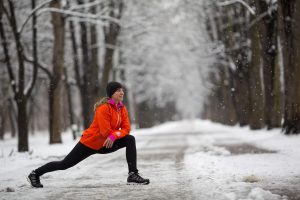For many thrill-seekers, winter is one the most exciting times of the year. Activities like snowboarding, ice skating, sledding, skiing, and hockey are great ways to get outside during cold winter months. As orthopedic specialists, we know that these athletic pursuits are not without their risks.
Below are some of the most common sports injuries we diagnose and treat at Raleigh Orthopedic Clinic – learn more about how to avoid them and continue living an active and comfortable life.
Ankle Sprains
It’s one of the most typical injuries of winter sports. It occurs when a person lands on the exterior part of the foot and twists the foot inwards. In consequence, the tissue on the outside of the foot over-stretches and tears. The result of this injury is often swelling and pain.
Knee Injuries
Knee injuries, which are quite common in skiers, can range from repetitive strains that heal rather quickly to more serious ACL tears that require in-depth surgery to address. Ligament injuries can cause excruciating pain and limit the extent of your mobility.
Tears such as ACL (anterior cruciate ligament), MCL (medial collateral ligament), LCL (lateral collateral ligament), and PCL (posterior cruciate ligament) usually involve intervention by an orthopedic surgeon and physical therapy to heal.
Hand Wrist Fractures and Sprains
A wrist sprain occurs when the ligaments that support the wrist stretch beyond their normal limits or tear. Ligaments are strong, fibrous tissues that keep your bones in proper position and stabilize the joint. Your wrist can suddenly twist or bend, such as by falling onto an outstretched hand. Wrist sprains are common injuries and can range from mild to severe, depending on how much damage there is to the ligaments.
Fractures encompass a wide range of injuries where there is a break or crack in one or more of the bones in your hand or wrist. Hand fractures affect the small bones of the fingers (phalanges) and the long bones within the palm (metacarpals). Wrist fractures affect the scaphoid bone, one of the eight small bones that make up the wrist.
Dislocated Shoulder
The shoulder joint is the body’s most mobile joint. It can turn in many directions, but this advantage also makes the shoulder an easy joint to dislocate. The shoulder is a ball-and-socket joint and is made up of three bones: the upper arm bone (humerus), the shoulder blade (scapula) and the collarbone (clavicle). A partial dislocation (subluxation) means the head of the upper arm bone is partially out of the socket (glenoid). A complete dislocation means it is all the way out of the socket. Both partial and complete dislocations cause pain and unsteadiness in the shoulder. One common instance is when a hockey player hits his shoulder against the boards.
Injury Prevention
- Stay Conditioned – Incorporate resistance training into daily exercise routines to build/strengthen muscles and their connective tissues.
- Implement a nutritious diet into your day-to-day meals, with adequate calcium and vitamin D.
Wear Proper Equipment – In order to prevent an ankle sprain, use snug-fitting ski boots with correctly adjusted fastenings. Helmets should fit snugly, comfortably, and straps, as applicable, should be fastened securely prior to practicing or playing. Knee guards, wrist pads, and elbow pads are also helpful in preventing impact injuries.
- Warm Up and Cool Down Stretch 8 to 10 minutes before and after exercising to loosen tight muscles. The warm up process increases muscle temperature, leading to the dissociation of oxygen from hemoglobin, improving metabolic chemical reactions and cellular processes. With a proper warm up such as light jogging, muscles are able to move quickly and efficiently, reducing the risk of musculoskeletal sports-related injuries. A cool down routine following periods of heavy exercise is just as important to slowly decrease body temperature and lower your heart rate. Simple movements, like stretching or foam rolling, will help the body dispose of harmful toxins that may cause muscle stiffness or aches.
- Stay hydrated – Hydration helps regulate body temperature, lubricate joints, and transport nutrients throughout the body. Making sure that you are hydrated will also reduce muscle cramps and avoid dizziness/lightheadedness during winter sports activities.
- Learn how to fall – Shoulder, elbow, and wrist injuries such as fractures or dislocations often result from trying to brace during a fall. Don’t place your hands or arms in front of you to stop a fall. Instead, try to fall on your glutes or on your side so your body can more safely absorb the impact.
- Know your limits and stop when you’re tired – The frequency of accidents increases when you’re fatigued. Avoid pushing your physical capabilities if you are not ready to perform a certain sport, movement, or trick – that is when injuries are more likely to occur.
Schedule an appointment at Raleigh Orthopaedic
At Raleigh Orthopaedic, our team of sports medicine specialists are committed to providing you with the best possible treatment and long-term outcome for your injury or condition. Click here or call us at (919) 781-5600 to schedule an appointment with one of our orthopedic specialists. If your injury or condition is recent, you can walk right into one of our Raleigh Orthopaedic Urgent Care locations for immediate care. For rehabilitation and physical therapy, no referral is needed to see one of our physical therapists
